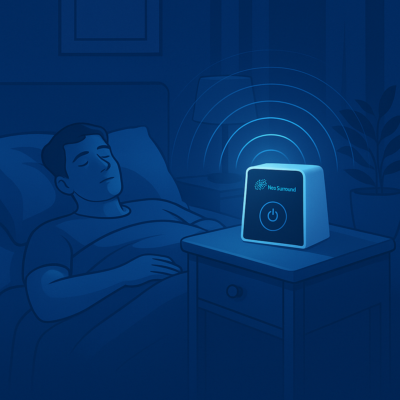
Sleep Better, Recover Faster: How NeoSurround Fits Into Your Night Routine
Your Evenings Deserve Balance Good sleep isn’t just about closing your eyes — it’s a biological process. Your…

When it comes to understanding health and stress resilience, one measurement stands out more and more in both scientific and wellness communities: Heart Rate Variability (HRV). It’s not only a fitness metric used by athletes but also a powerful window into how well your nervous system — and particularly your vagus nerve — is functioning. […]
When it comes to understanding health and stress resilience, one measurement stands out more and more in both scientific and wellness communities: Heart Rate Variability (HRV). It’s not only a fitness metric used by athletes but also a powerful window into how well your nervous system — and particularly your vagus nerve — is functioning.
Let’s break down what HRV is, why it matters for your health, and how stimulating the vagus nerve can help improve it naturally.
Table of Contents
Most people think of the heartbeat as steady and rhythmic, like a metronome. But in reality, the time between individual heartbeats — measured in milliseconds — is always slightly changing.
That variation is called Heart Rate Variability.
A high HRV means your heart is able to quickly adjust between states of stress and relaxation. This is a sign of good adaptability and resilience.
A low HRV means your heart rhythm is more rigid, often indicating stress, fatigue, or poor recovery.
In other words, HRV reflects how flexible and responsive your nervous system is.
High HRV shows that your body can handle stress effectively and then recover quickly. Low HRV, on the other hand, suggests that your system is “stuck” in stress mode.
HRV is closely tied to the quality of your rest. During deep, restorative sleep, HRV usually increases as the body repairs and balances itself.
Athletes use HRV to track training load and recovery. A consistently low HRV can be an early sign of overtraining or burnout.
Studies link higher HRV with lower risks of cardiovascular disease, better mental health, and improved immune function. Low HRV is often seen in chronic stress, anxiety, depression, and inflammatory conditions.
Simply put: HRV is a valuable marker for how well your body adapts to life’s demands.
The vagus nerve is one of the most important regulators of HRV.
Here’s why:
The vagus nerve activates the parasympathetic nervous system, responsible for calming the body.
When vagal tone (the strength of vagus nerve activity) is high, your body can switch more easily from stress mode to relaxation mode.
Strong vagal activity = higher HRV.
This makes HRV not just a heart metric, but also a direct reflection of vagus nerve health.
The exciting part? HRV isn’t fixed. You can train your body to improve it — and many methods revolve around supporting the vagus nerve.
Slow, deep, diaphragmatic breathing is one of the most effective ways to activate the vagus nerve. Try inhaling for 4 seconds, exhaling for 6 seconds.
Splashing your face with cold water or ending your shower with a burst of cold activates vagal pathways.
Relaxation practices reduce stress hormones and stimulate vagal activity.
The vagus nerve connects to vocal cords. Vibrations from humming or chanting provide gentle stimulation.
Research suggests that PEMF can gently stimulate the vagus nerve without discomfort or invasiveness. By enhancing vagal tone, PEMF helps improve HRV, making the body more resilient against stress and supporting recovery. Unlike electrical stimulation, PEMF works in harmony with natural bioelectrical rhythms, making it a safe, non-invasive option.
Many wearable devices today (like Oura Ring, WHOOP, or certain smartwatches) can measure HRV continuously. Monitoring your HRV can help you:
See how lifestyle changes impact your stress resilience.
Identify early signs of fatigue, illness, or overtraining.
Stay motivated as you watch your HRV improve with regular vagus-supporting practices.
Heart Rate Variability is more than just a number — it’s a reflection of how adaptable, resilient, and balanced your nervous system is. And at the center of that system is the vagus nerve.
By supporting vagal tone through natural practices like breathing, mindfulness, and innovative technologies such as PEMF therapy, you can raise your HRV and give your body the tools it needs to thrive.
A stronger vagus nerve means a higher HRV. And a higher HRV means better stress resilience, deeper sleep, and stronger overall health.
Check other research on Neopemf.com